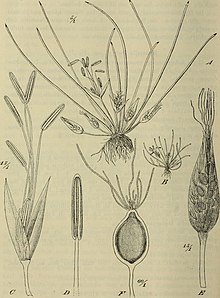Trithuria australis
| Trithuria australis | |
|---|---|

| |
| Botanical illustration of Trithuria australis | |
| Scientific classification | |
| Kingdom: | Plantae |
| Clade: | Tracheophytes |
| Clade: | Angiosperms |
| Order: | Nymphaeales |
| Family: | Hydatellaceae |
| Genus: | Trithuria |
| Species: | T. australis
|
| Binomial name | |
| Trithuria australis | |

| |
| Trithuria australis is endemic to Western Australia[1] | |
| Synonyms[1] | |
| |
Trithuria australis is a species of aquatic plant in the family Hydatellaceae endemic to Western Australia.[1]
Description
[edit]Vegetative characteristics
[edit]Trithuria australis is an annual,[2] submerged aquatic plant. The terete, pointed leaves are 20–25 mm long, and 0.3 mm wide.[3]
Generative characteristics
[edit]The reproductive units ("flowers") are unisexual. Both female and male reproductive units are present on the same plant.[2] The reproductive units are sessile or exhibit very short peduncles.[4] The male reproductive unit has 3-8 stamens.[2] The seed coat is brown[3] and smooth.[2] It is believed to be self-pollinating.[4][5][6]
Cytology
[edit]The chromosome count is 2n = 14.[5]
Distribution
[edit]It is known from several populations[5] occurring in the Western and Southwestern parts of the state Western Australia.[2]
Taxonomy
[edit]Trithuria australis (Diels) D.D.Sokoloff, Remizowa, T.D.Macfarl. & Rudall was first described as Hydatella australis Diels by Friedrich Ludwig Emil Diels in 1904.[1][3] Later it was included in the genus Trithuria Hook.f. as Trithuria australis (Diels) D.D.Sokoloff, Remizowa, T.D.Macfarl. & Rudall by Dmitry Dmitrievich Sokoloff, Margarita Vasilyena Remizowa, Terry Desmond Macfarlane & Paula J. Rudall in 2008.[1][2] The type specimen was collected by L. Diels in Hamersley River, Western Australia in October 1901.[2] It is included in Trithuria sect. Hydatella (Diels) D.D. Sokoloff, Iles, Rudall & S.W. Graham, of which it is the type species.[5]
Etymology
[edit]The specific epithet australis means southern.[7][8]
Ecology
[edit]Habitat
[edit]It grows in swamps. It occurs sympatrically with Centrolepis.[4]
References
[edit]- ^ a b c d e f "Trithuria australis (Diels) D.D.Sokoloff, Remizowa, T.D.Macfarl. & Rudall". Plants of the World Online. Royal Botanic Gardens, Kew. Retrieved 23 October 2024.
- ^ a b c d e f g Sokoloff, D. D., Remizowa, M. V., Macfarlane, T. D., & Rudall, P. J. (2008). Classification of the early‐divergent angiosperm family Hydatellaceae: One genus instead of two, four new species and sexual dimorphism in dioecious taxa. Taxon, 57(1), 179-200.
- ^ a b c Diels, L., & Pritzel, E. (1905). Fragmenta Phytographiae Australiae occidentalis. Beiträge zur Kenntnis der Pflanzen Westaustraliens, ihrer Verbreitung und ihrer Lebens-Verhältnisse. In Botanische Jahrbücher fur Systematik, Pflanzengeschichte und Pflanzengeographie (Vol. 35, pp. 55–160). https://www.biodiversitylibrary.org/page/126540
- ^ a b c Taylor, Mackenzie Lorraine, "Developmental Evolution of the Progamic Phase in Nymphaeales. " PhD diss., University of Tennessee, 2011. https://trace.tennessee.edu/utk_graddiss/1031
- ^ a b c d Iles, W. J. D. (2013). The phylogeny and evolution of two ancient lineages of aquatic plants (Doctoral dissertation, University of British Columbia).
- ^ Smissen, R. D., Ford, K. A., Champion, P. D., & Heenan, P. B. (2019). Genetic variation in Trithuria inconspicua and T. filamentosa (Hydatellaceae): a new subspecies and a hypothesis of apomixis arising within a predominantly selfing lineage. Australian Systematic Botany, 32(1), 1-11.
- ^ A Grammatical Dictionary of Botanical Latin. (n.d.-b). Retrieved October 28, 2024, from http://www.mobot.org/mobot/latindict/keyDetail.aspx?keyWord=australis
- ^ Daniels, R. (2020, May 30). Demystifying native plant names – an introduction. Australian Plants Society - NSW. Retrieved October 28, 2024, from https://resources.austplants.com.au/stories/demystifying-native-plant-names-an-introduction/
